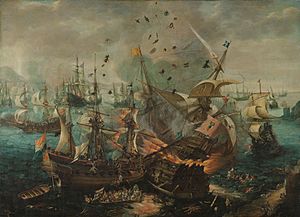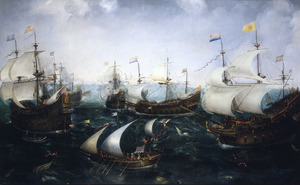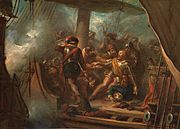Battle of Gibraltar (1607) facts for kids
Quick facts for kids Battle of Gibraltar |
|||||||
|---|---|---|---|---|---|---|---|
| Part of the Eighty Years' War | |||||||
 Battle of Gibraltar by Cornelis van Wieringen |
|||||||
|
|||||||
| Belligerents | |||||||
| Commanders and leaders | |||||||
| Jacob van Heemskerk † | Juan Álvarez de Avilés † | ||||||
| Strength | |||||||
| 26 warships |
|
||||||
| Casualties and losses | |||||||
|
|
||||||
The Battle of Gibraltar was a big naval fight. It happened on April 25, 1607. This battle was part of the Eighty Years' War. A Dutch fleet surprised a Spanish fleet that was resting in the Bay of Gibraltar. In just four hours, most of the Spanish ships were destroyed.
Contents
Ships and Commanders
The Dutch Fleet
A Dutch fleet of 26 warships took part in the battle. It was led by Jacob van Heemskerk. His main ship was called Æolus. Other Dutch ships included De Tijger, De Zeehond, De Griffioen, and De Roode Leeuw. There were also De Gouden Leeuw, De Zwarte Beer, De Witte Beer, and De Ochtendster.
The Spanish Fleet
The Spanish fleet had 21 ships. Ten of these were large warships called galleons. Don Juan Álvarez de Avilés led the Spanish fleet. His main ship was the San Augustin, commanded by his son. Other Spanish ships were Nuestra Señora de la Vega and Madre de Dios. A fortress on land was supposed to protect the Spanish ships. However, the Dutch fleet stayed too far away for the fortress's guns to reach them. This meant the fortress could not help in the battle.
The Battle Begins
Admiral Van Heemskerk made a clever plan. He placed some of his ships at the entrance of the bay. This stopped any Spanish ships from escaping. Twenty Dutch ships were told to attack the big Spanish galleons. The rest of the Dutch ships focused on the smaller Spanish vessels.
Fierce Fighting
Sadly, Admiral Van Heemskerk was killed early in the battle. This happened during the first attack on the Spanish flagship. Even without their leader, the Dutch kept fighting hard. They attacked the galleons with great force. Some of the Spanish galleons caught fire. One even exploded when a cannonball hit its gunpowder storage. The Dutch captured the Spanish flagship. But they then let it float away, empty and damaged.
Aftermath of the Battle
After destroying the Spanish ships, the Dutch sent out small boats. They killed hundreds of Spanish sailors who were trying to swim to safety. The Dutch lost about 100 men, including their brave Admiral Van Heemskerk. Sixty Dutch sailors were also wounded. Most, or even all, of the Spanish ships were lost. Between 350 and 4,000 Spanish sailors were killed or captured. The Spanish commander, Álvarez de Avilés, was among those who died.
What Happened Next
The Twelve Years' Truce
This important battle helped lead to the Twelve Years' Truce. This was a peace agreement. It meant that the Dutch Republic was officially recognized by the Spanish Crown. It was a big step for the Netherlands.
Impact on Ireland
The Battle of Gibraltar also had an unexpected effect on the History of Ireland. Two Irish leaders, Hugh O'Neill, 2nd Earl of Tyrone, and Rory O'Donnell, 1st Earl of Tyrconnell, had left Ireland. They hoped to get a Spanish army to invade Ireland and help them. But the Spanish fleet was destroyed at Gibraltar. This meant Spain could not send an army to Ireland. The Irish Earls could not go back home. This event, known as the "Flight of the Earls", had major effects on Ireland's history, especially in Ulster.
Gallery
See also
 In Spanish: Batalla de Gibraltar (1607) para niños
In Spanish: Batalla de Gibraltar (1607) para niños







